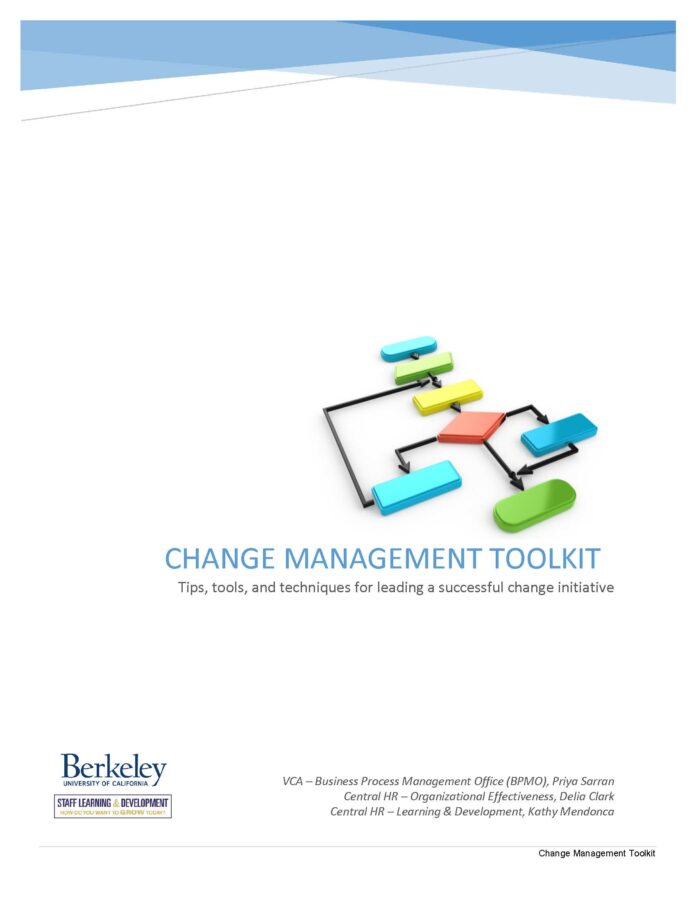Who is this change management toolkit for?
This toolkit is designed for any individual responsible for leading a change initiative of any size.
How to use this change management toolkit?
This toolkit begins with an introduction to the importance of change management and goes over the seven components necessary to effectively manage change. It is organized into four main sections:
- Change Management Pre-work
- Manage Personal Transitions (resistance)
- Develop Change Plan
- Implement & Monitor the Change.
Each of these sections contains a collection of tools and techniques which organize the work needed for the change initiative and they are best followed chronologically.
While a multitude of tools is provided, not all tools will be necessary for every change. When considering which tools to use, review the scope of the change identified in the Project Charter. For large-scale initiatives, it is recommended that all tools be used in each section of the toolkit. For small to medium-sized initiatives, at a bare minimum, the following tools should be used:
- Case for change template (page 7)
- Compelling vision Interview template (page 8)
- Change communication plan overview & template (pages 40-41)
- Change Readiness assessment (page 16)
- Manage Personal Transitions (resistance) Section (pages 21-29)
- Feedback Strategy Overview & Options (pages 37-38)
- Behavioral change Plan (page 17)
Why Change Management?
As a top-ranked public research university, UC Berkeley serves as a flagship institution when it comes to our bold and innovative initiatives. Change management is often the key component in driving the success of these ventures. As we know from our own experience, not all change initiatives are equally disruptive. Some will have a greater impact and be more challenging. Others may be barely noticeable.
Change can be bucketed into two main categories: Incremental and Transformational. Incremental change is easier to implement successfully. It is often based on the current state in order to improve the existing way of doing our work. It typically involves fewer changes and affects a small number of people. On the other hand, Transformational change is more difficult to implement, typically having only a 30% success rate. (Taking Stock survey by The Change Management Toolbook, February 2005) Why is that?
Things get more challenging when the change is Transformational because it is designed from a future state and involves a fundamentally new way of doing things. This typically involves significant culture change and affects a large number. The complexity involved in culture change is often why it is easier to change the change than it is to change the culture.
To change behavior (our own or someone else’s), we must do three things:
1. Direct the Rider: make the destination crystal clear The Rider has their own issues. A Rider likes to contemplate and analyze information before deciding on a direction. When a Rider isn’t sure exactly which direction to go, they lead the Elephant in circles. Often, what looks like resistance is actually lack of clarity.
2. Motivate the Elephant: make people feel the need for a change When an individual’s six-ton Elephant is not in agreement with the direction their Rider wants to go, the Rider is going to lose. The Rider may get their way temporarily, through close monitoring and exerting self-control, but in the long term, the Elephant will ALWAYS overpower the Rider. Why? Self-control is an exhaustible resource. Often what looks like resistance is actually exhaustion. Motivation provides the energy the Rider needs to maintain self-control; a lack of motivation may doom a change effort.
3. Shape the Path: make the required changes specific To direct the Rider and motivate the Elephant, we need to shape the Path by focusing on the situation, including the surrounding environment, to make the change more likely. Being specific narrows the focus, so the Elephant and the Rider are more likely to stay traveling together toward the goal. Often, what looks like resistance is actually a lack of direction.


